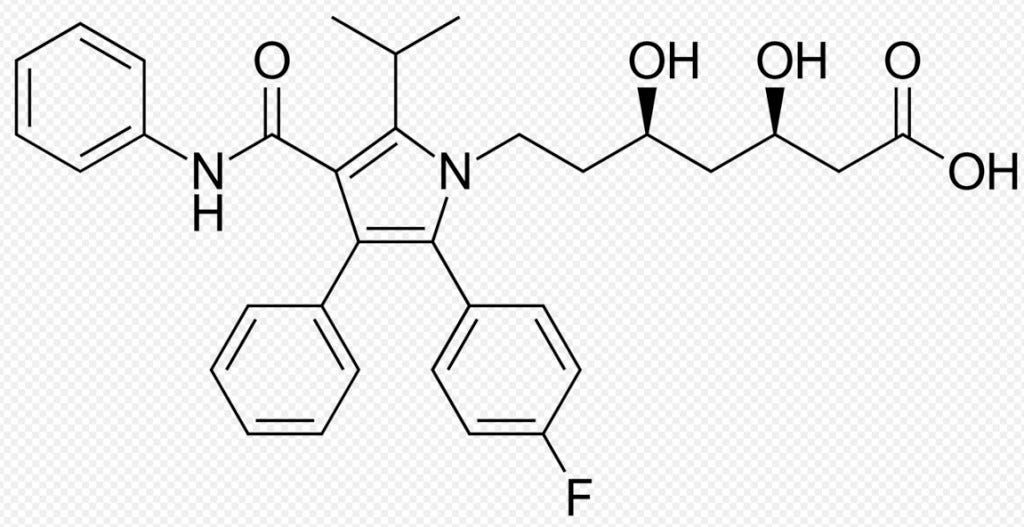Drug Lesson #3: Atorvastatin
Welcome to the third drug lesson in this series! I am trying to cover some of the most common medications used in clinical practice, and this drug is no exception.

Welcome to the third drug lesson in this series! I am trying to cover some of the most common medications used in clinical practice, and this drug is no exception. In 2015–2016, more than 12% of adults age 20 and older had total cholesterol higher than 240 mg/dL, and more than 18% had high-density lipoprotein (HDL, or “good”) cholesterol levels less than 40 mg/dL.1
Millions of people have high cholesterol, and many of them do not experience any symptoms. High cholesterol for a long period of time increases the risk of heart disease, heart attacks, and death. The drug I am talking about today does an incredible job in controlling cholesterol and preventing heart-related morbidities.
What is atorvastatin?
Medications like atorvastatin target an enzyme named HMG-CoA reductase. HMG-CoA reductase is involved in the biosynthesis of cholesterol. By inhibiting HMG-CoA reductase, atorvastatin inhibits cholesterol production and lowers cholesterol levels in the body.

Atorvastatin belongs to a class of drugs called statins. All medications in this class work the same to decrease overall cholesterol production. The transformation of HMG CoA to mevalonate by HMG-CoA reductase is considered the rate-limiting step in cholesterol biosynthesis. The rate-limiting step in a chemical reaction is the chemical reaction in a series of sequential reactions that takes the longest to occur.
Why is the rate-limiting step important? This is because the whole process relies on the speed of this reaction, and slowing or preventing the reaction will impact the whole process the most. That is why the statins target this step in cholesterol biosynthesis.
When do we use it?
Atorvastatin is FDA indicated for use in those with atherosclerotic cardiovascular disease (ASCVD). This includes disease states like acute coronary syndrome (ACS), diabetes mellitus (DM), and others. According to the American Heart Association (AHA) guidelines on primary prevention of heart disease2, patients aged 20–75 years with an LDL-C of > or equal to 190 mg/dl require a high-intensity statin without any primary risk assessment. A high-intensity statin refers to the dosage of statin therapy that has the highest effectiveness.
Atorvastatin is one of two statins that have high-intensity dosing, at 40 mg and 80 mg3. The drug is one of the most common statins used in practice for its familiarity and lower price tag.
What about the side effects?
With many oral medications, atorvastatin can cause some gastrointestinal (GI) upset. This includes diarrhea, nausea, or vomiting. The most important side effect that patients experience with atorvastatin is muscle pain.

Muscle pain can happen anywhere in the body. For some, the pain is bothersome at most; for others, it’s unbearable. Around 9 to 12% of patients taking atorvastatin develop muscular symptoms like pain, weakness, or throbbing.
When should a patient NOT be taking atorvastatin?

- If a patient experiences hypersensitivity (allergic reaction) to atorvastatin, they should stop the medication immediately.
- Patients with active liver disease should not be taking atorvastatin, considering the medication is metabolized in the liver.
Can pregnant people take atorvastatin?
Atorvastatin is contraindicated in pregnancy, and physicians should immediately discontinue the drug if their patients are pregnant or trying to get pregnant. The use of adequate contraception in sexually active patients is mandatory.
Extra Tips!
- take atorvastatin at bedtime for best absorption and minimal side effects
- avoid drinking alcohol because taking both together can increase blood alcohol levels
- avoid grapefruit juice because it inhibits the breakdown of atorvastatin in the liver
References
- Carroll M, Fryar C, Nguyen D. HDL, National Health and Nutrition Examination Survey: Total and High-density Lipoprotein Cholesterol in Adults: United States, 2015–2016. NCHS data brief, no. 290. Hyattsville, MD: National Center for Health Statistics; 2017.
- 2019 ACC/AHA Guideline on the Primary Prevention of Cardiovascular Disease: A Report of the American College of Cardiology/American Heart Association Task Force on Clinical Practice Guidelines. J Am Coll Cardiol 2019;March 17.
- Atorvastatin monograph, Lexicomp Medical.